Experimental Study on the Peeling Fracture Effect of Fresh Corn Ear Based on High and Low Roller Peeling Equipment
Abstract
:1. Introduction
2. Structural Design and Working Principle of the Whole Machine
3. Dynamics Analysis of the Peeling Rollers
3.1. Force Analysis of Peeling Force of Fresh Corn Ears
3.2. Force Analysis of Sliding Conditions of Fresh Corn Ear
4. Materials and Methods
4.1. Test Platform
4.2. Test Conditions
4.3. Evaluation Indicators
5. Experiment and Results Analysis
5.1. Test Results
5.2. Multiple Linear Regression Significance Analysis
5.2.1. Significance Analysis of BPR
5.2.2. Significance Analysis of GBR
5.3. Analysis Based on Response Surface Methodology
5.3.1. Effect of Factor Interactions on BPR
5.3.2. Effect of Factor Interactions on GBR
5.4. Parameter Optimization and Verification
6. Discussion
7. Conclusions
- (1)
- Taking into consideration the physical characteristics of fresh corn ears, a high–low roller peeling machine was developed with a focus on the design and function of its peeling roller device. The structural design and working principle of the peeling roller device were thoroughly examined. By applying theoretical analysis, a dynamic model specific to the interaction between the corn ear and the machine was developed. This allowed for the determination of the parameters necessary for the peeling mechanism, as well as the identification of the key factors influencing its working performance.
- (2)
- To conduct experiments on the peeling process of fresh corn, three factors were selected for testing: peeling roller speed, peeling roller tilting angle, and frequency vibration plate vibration times per minute. The BPR and GBR were chosen as the evaluation criteria for the experiments. A three-factor quadratic regression orthogonal combination test plan was adopted to carry out the tests. This approach helps to systematically explore the relationships between the selected factors and the test indices, providing valuable insights into optimizing the peeling process for fresh corn.
- (3)
- The test data obtained from the experiments were analyzed and optimized using Design-Expert 12 software. By applying the software, the best parameter combinations for the test factors were determined. These included a peeling roller speed of 478.72 r/min, a peeling roller tilting angle of 8.05°, and a frequency vibration plate of 259.20 times/min. Under these conditions, the peeling process resulted in a BPR of 92.41% and a GBR of 1.47%. In the validation test, the optimized parameter combinations were implemented, resulting in a BPR of 91.75% and a GBR of 1.55% for fresh corn ears. The results from the parameter optimization were consistent with the validation test, indicating that the optimized equipment met the design requirements effectively.
Author Contributions
Funding
Institutional Review Board Statement
Informed Consent Statement
Data Availability Statement
Conflicts of Interest
References
- Agackesen, M.N.; Oktem, A.G.; Oktem, A. Effect of Harvest at Different Maturation Stages on Fresh Ear Yield and Ear Characteristics of Sweet Corn (Zea mays L. saccharate) Genotypes. Appl. Ecol. Environ. Res. 2022, 20, 3335–3351. [Google Scholar] [CrossRef]
- Lu, B.; Dong, H.; Xu, L.; Shi, Y.; Zhao, J.; Fan, Y.; Yu, Y. Relationship Between Water Content and Physical Properties and Quality of Sweet Corn at Different Harvesting Periods. Acta Agric. Boreali-Sin. 2019, 34, 69–77. [Google Scholar]
- Vladimir, I.T.; Igor, Y.S.; Julia, M.S.; Lyudmila, A.L.; Helena, N.L. Contemporary State of Resource Potential of Agriculture in South Russia. Int. J. Econ. Financ. Issues 2016, 6, 33–41. [Google Scholar]
- Samomssa, I.; Nono, Y.J.; Cârâc, G.; Gurău, G.; Dinică, M.R.; Kamga, R. Optimization of fuel briquette production from cassava peels, plantain peels and corn cobs. J. Mater. Cycles Waste Manag. 2021, 23, 1905–1917. [Google Scholar] [CrossRef]
- Djafar, R.; Staddal, I.; Liputo, B. Dissemination of portable combining machine as appropriate technological adoption for corn farming in sloping region study case: Gorontalo Province, Indonesia. In Proceedings of the IOP Conference Series: Earth and Environmental Science, Banda Aceh, Indonesia, 21 September 2021. [Google Scholar]
- Astanakulov, K.D.; Fozilov, G.G.; Kodirov, B.K.; Khudaev, I.; Shermukhamedov, K.; Umarova, F. Theoretical and experimental results of determination of the peeler-bar parameters of corn-thresher. In Proceedings of the IOP Conference Series: Earth and Environmental Science, Tashkent, Uzbekistan, 14–16 October 2020. [Google Scholar]
- Chen, X.; Rong, M.; Guo, Y.; Xu, Z.; Wang, Q.; Yu, X.; Xin, Y.; Jia, X.; Jiang, L. Qualitative Dynamics of Waxy Maize (Jikenuo 19) in Different Harvest Times. Bangladesh J. Bot. 2021, 50, 987–992. [Google Scholar] [CrossRef]
- Lu, Y.C.; Watkins, K.B.; Teasdale, J.R.; Abdul-Baki, A.A. Cover crops in sustainable food production. Food Rev. Int. 2000, 16, 121–157. [Google Scholar] [CrossRef]
- Ketthaisong, D.; Suriharn, B.; Tangwongchai, R.; Lertrat, K. Changes in physicochemical properties of waxy corn starches after harvest, and in mechanical properties of fresh cooked kernels during storage. Food Chem. 2014, 151, 561–567. [Google Scholar] [CrossRef]
- Luo, H.; Nie, J.; Zhang, L. Design and Test of Dislocation Baffle Roller Bionic Picking Device for Fresh Corn. Agriculture 2023, 13, 991. [Google Scholar] [CrossRef]
- Li, Z.; Hong, T.; Zhao, Z.; Gu, Y.; Guo, Y.; Han, J. Fatty Acid Profiles and Nutritional Evaluation of Fresh Sweet-Waxy Corn from Three Regions of China. Foods 2022, 11, 2636. [Google Scholar] [CrossRef] [PubMed]
- Li, Z.; Hong, T.; Shen, G.; Gu, Y.; Guo, Y.; Han, J. Amino Acid Profiles and Nutritional Evaluation of Fresh Sweet-Waxy Corn from Three Different Regions of China. Nutrients 2022, 14, 3887. [Google Scholar] [CrossRef]
- Berger, L.L.; Paterson, J.A.; Klopfenstein, T.J.; Britton, R.A. Effect of Harvest Date and Chemical Treatment on the Feeding Value of Corn Stalklage. J. Anim. Sci. 1979, 49, 1312–1316. [Google Scholar] [CrossRef]
- Shin, S.; Jung, G.-H.; Kim, M.-J.; Lee, J.-S.; Son, B.-Y.; Kim, J.-T.; Bae, H.-H.; Kim, S.-G.; Kwon, Y.-U.; Baek, S.-B. Effect of Planting Dates on Growth and Yield of Late-planted Sweet Corn (Zea mays L.) to Sell Fresh Ears in the Autumn. Korean J. Crop Sci. 2014, 59, 299–306. [Google Scholar] [CrossRef] [Green Version]
- Geng, A.; Hu, X.; Liu, J.; Mei, Z.; Zhang, Z.; Yu, W. Development and Testing of Automatic Row Alignment System for Corn. Appl. Sci. 2022, 12, 6221. [Google Scholar] [CrossRef]
- Zhao, Y.; He, X.; Shi, J.; Liu, Q.; Shao, G.; Xie, Q. Design and experiment of fresh corn peeling machine. Trans. Chin. Soc. Agric. Eng. (Trans. CSAE) 2011, 27, 114–118. [Google Scholar]
- Liu, L.; Liu, L.; Du, Y.; Mao, E.; Zhang, Y.; Yang, F. Design and experiment of seed corn peeling mechanism based on TRIZ theory. J. Agric. Mach. 2022, 53, 131–141. [Google Scholar]
- Yang, F.; Du, Y.; Fu, Q.; Li, X.; Li, Z.; Mao, E.; Zhu, Z. Design and testing of seed maize ear peeling roller based on Hertz theory. Biosyst. Eng. 2021, 202, 165–178. [Google Scholar] [CrossRef]
- Kedge, M.A.Y.; Mane, M.A.B.; Nadaf, M.N.H.; Devarshi, M.R.A. A Design of Compact Peeling-Shelling Machine. Int. Res. J. Eng. Technol. 2017, 4, 1148–1155. [Google Scholar]
- Gorad, M.S.; Naik, P.V.R. Design and Development of Corn Chaff Peeling Machine. Int. Res. J. Eng. Technol. 2019, 6, 538–544. [Google Scholar]
- Wang, Z.; Zhang, G.; Xu, H.; Zhou, Y.; Tang, N.; Zhang, H. Design and experiment of the clamping sheller for fresh water caltrop. Trans. Chin. Soc. Agric. Eng. (Trans. CSAE) 2022, 38, 9–19. [Google Scholar]
- Li, Z.; Fu, J.; Luo, X. Tensile properties and fracture mechanisms of corn bract for corn peeling device design. Agriculture 2021, 11, 796. [Google Scholar] [CrossRef]
- Xu, L.; Wang, Y.; Zhang, D.; Zhao, C.; Hou, Y. Design and experiment of universal corn peeling mechanism. J. Agric. Mach. 2011, 42, 14–20. [Google Scholar]
- Qin, J.; Yin, Y.; Liu, Z.; Du, Y.; Wang, G.; Zhu, Z.; Li, Z. Optimisation of maize picking mechanism by simulation analysis and high-speed video experiments. Biosyst. Eng. 2020, 189, 84–98. [Google Scholar] [CrossRef]
- Zhu, Z.; Yue, X.; Du, Y.; Song, Z.; Mao, E.; Wang, B. Dynamic simulation and high-speed photography experiment on corn-ear husking. Trans. Chin. Soc. Agric. Eng. (Trans. CSAE) 2015, 31, 42–48. [Google Scholar]
- GB/T 21962-2020; Corn harvesting Machinery Technical Conditions. National Standards of the People’s Republic of China. State Administration of Market Administration and Standardization Management Committee: Beijing, China, 2020.
- Kim, I.; Ha, J.-H.; Jeong, Y. Optimization of Extraction Conditions for Antioxidant Activity of Acer tegmentosum Using Response Surface Methodology. Appl. Sci. 2021, 11, 1134. [Google Scholar] [CrossRef]
- Zhang, Y.; Lu, X.; Li, W.; Yan, K.; Mo, Z.; Lan, Y.; Wang, L. Detection of Power Poles in Orchards Based on Improved Yolov5s Model. Agronomy 2023, 13, 1705. [Google Scholar] [CrossRef]
- Li, Z.; Fu, J.; Chen, Z.; Fu, Q.; Luo, X. Hyperspectral detection of fresh corn peeling damage using germinating sparse classification method. Front. Plant Sci. 2022, 13, 1039110. [Google Scholar] [CrossRef] [PubMed]
- Xie, F.; Song, J.; Huo, H.; Hou, X. Experiment and mechanical characteristics on bract peeling of corn harvester. J. Agric. Mech. Res. 2018, 40, 129–133. [Google Scholar]
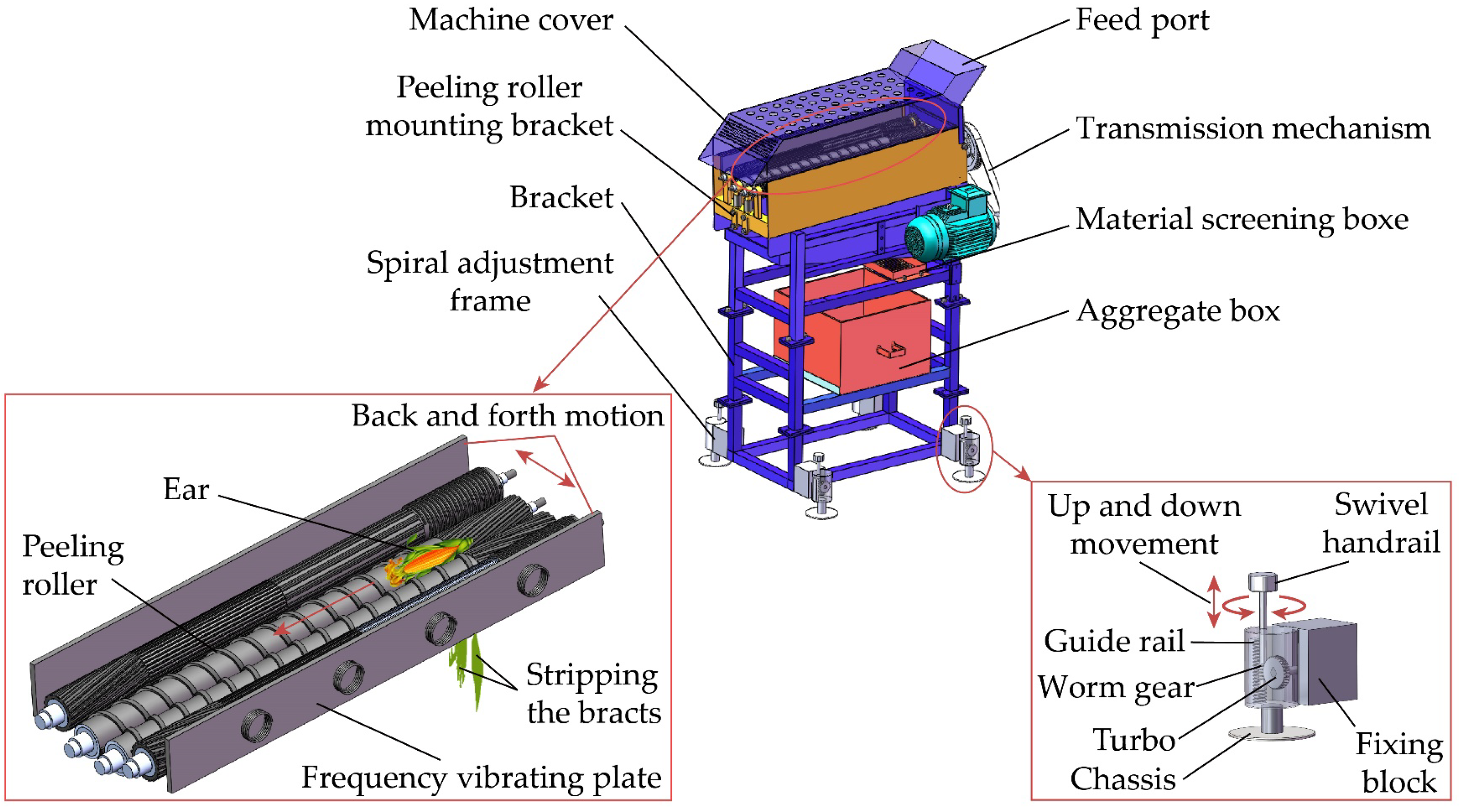
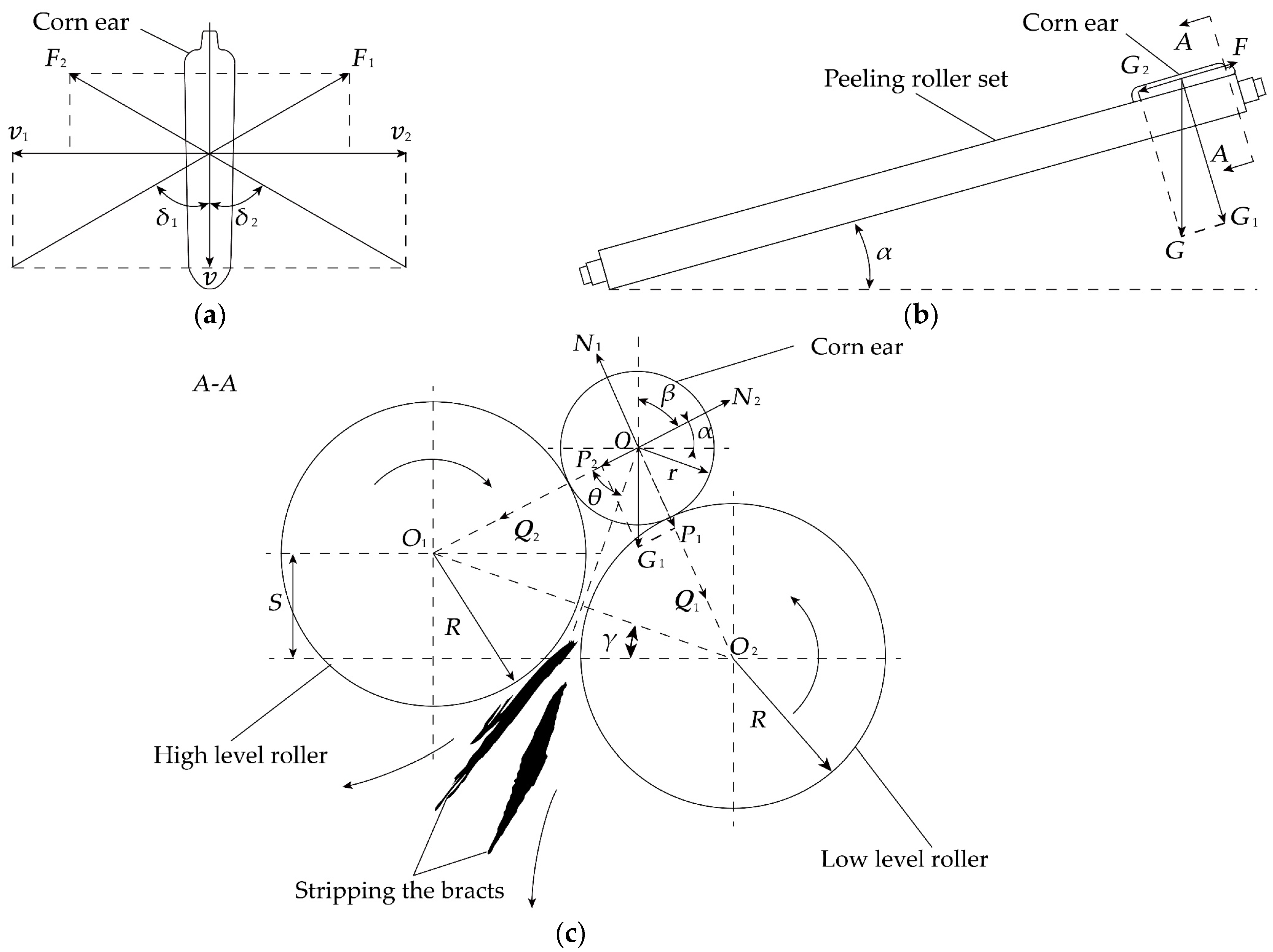
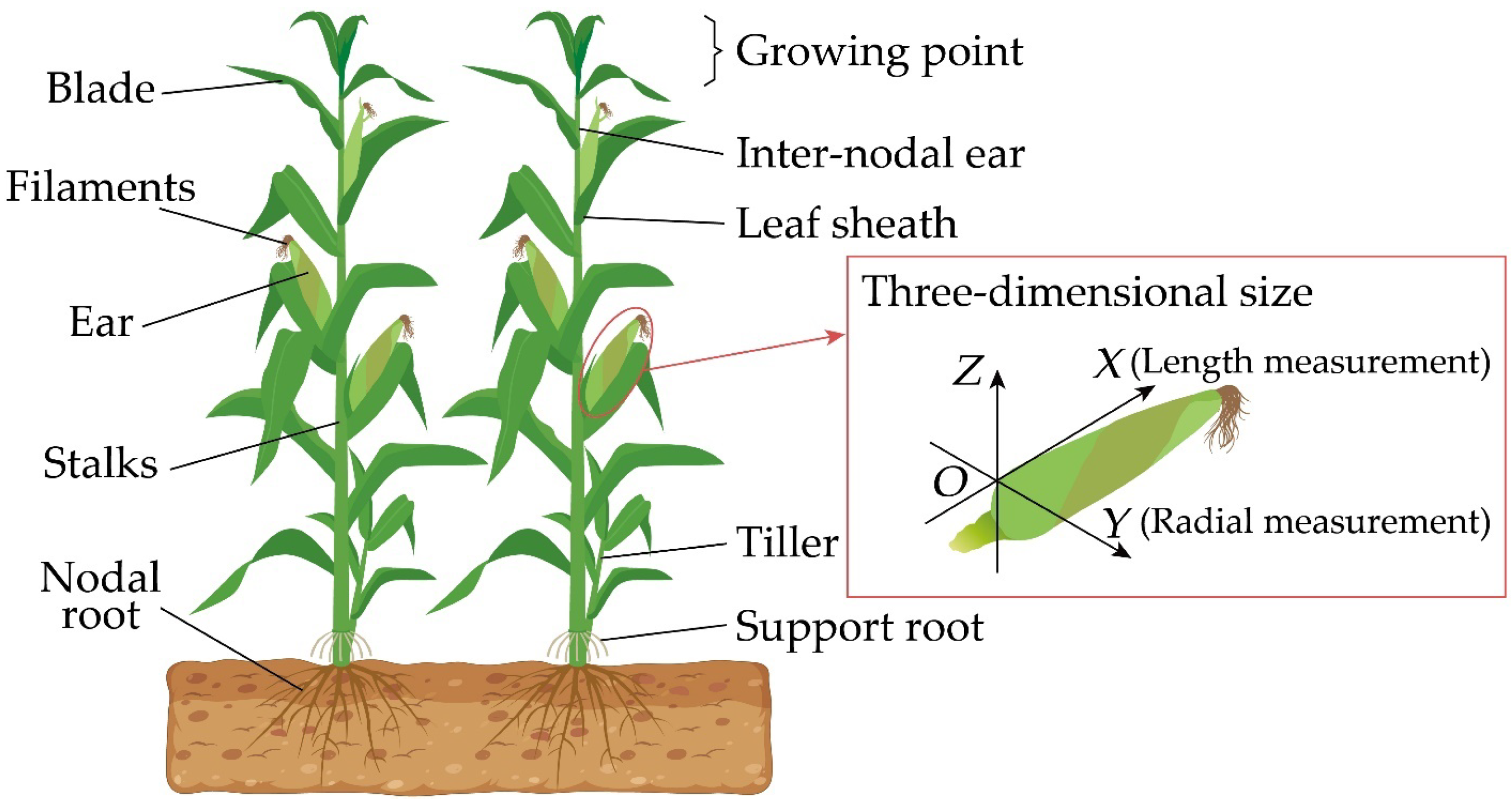
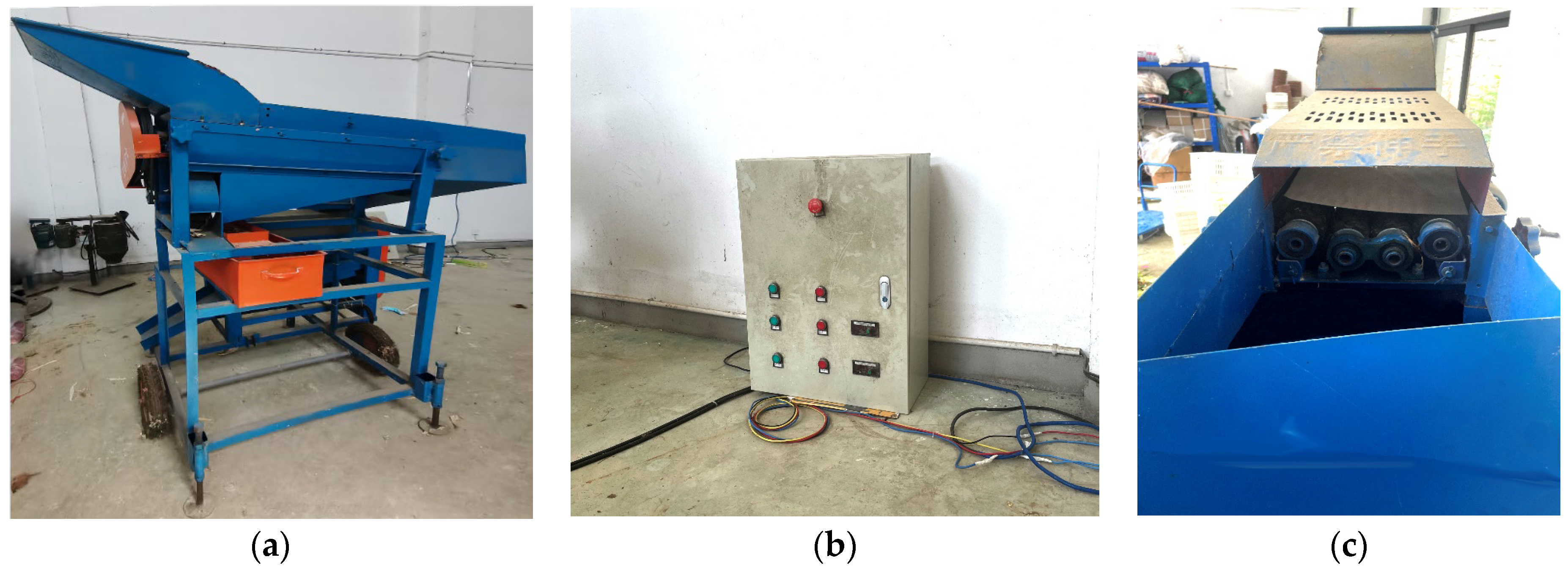
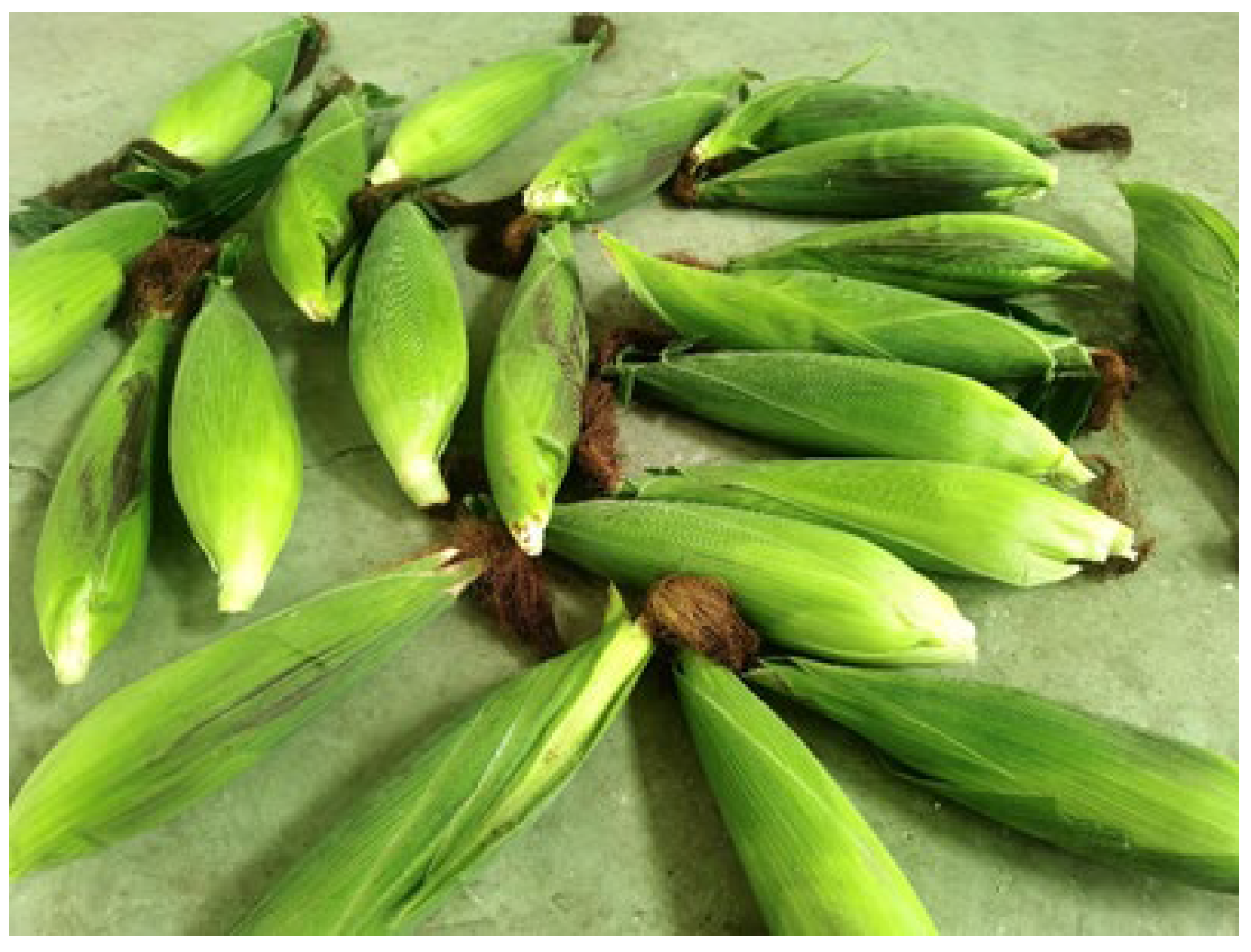
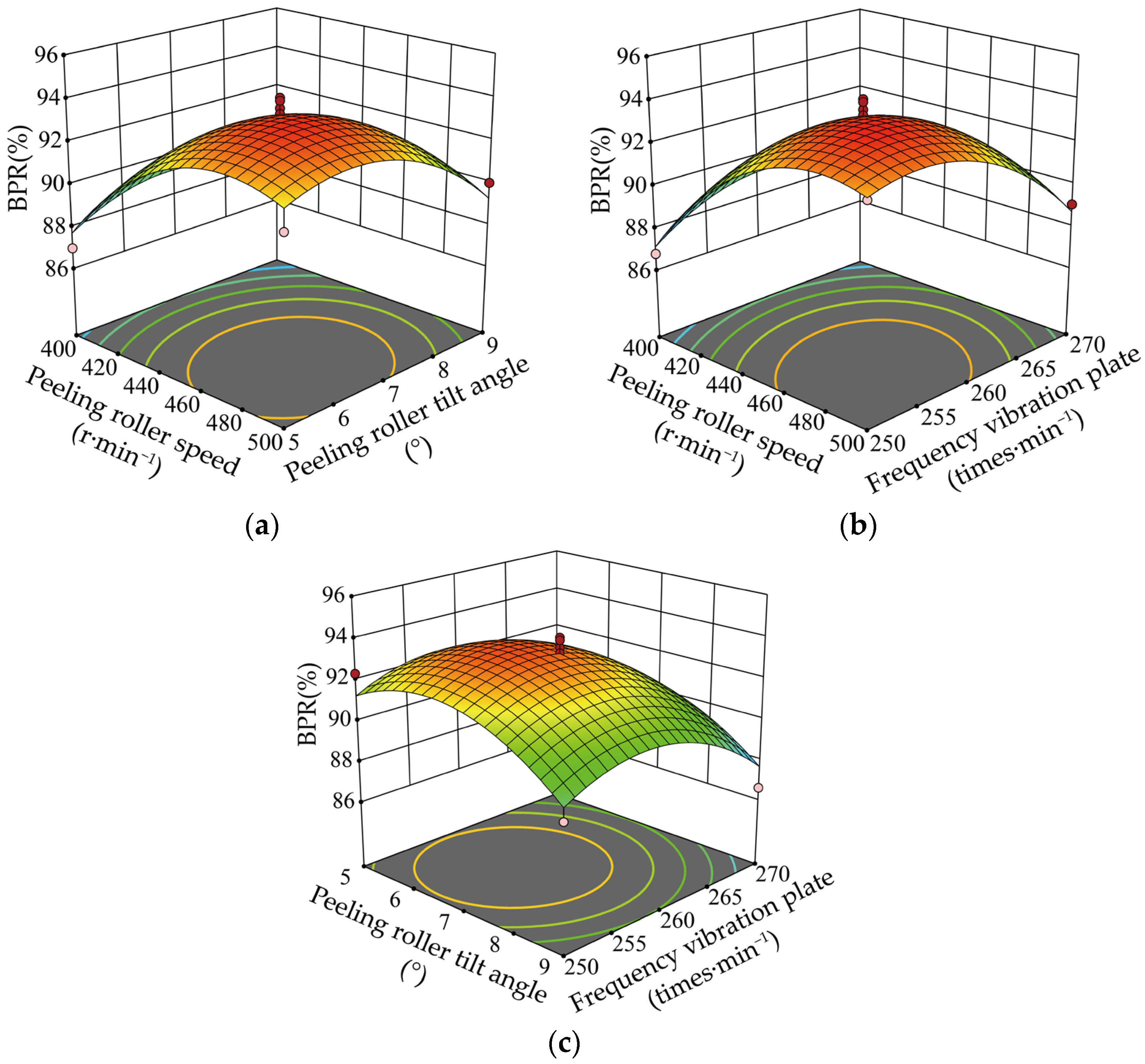
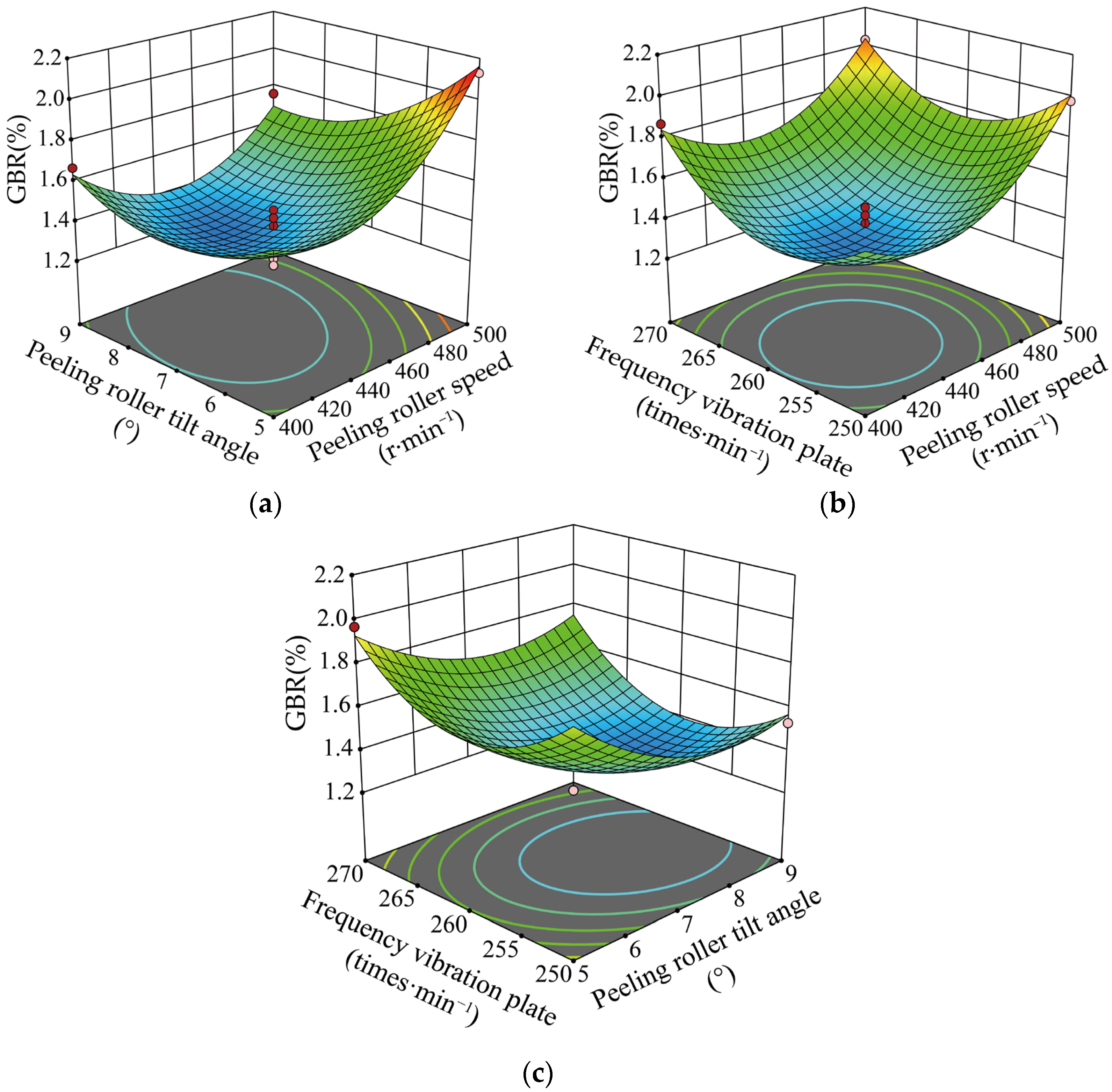
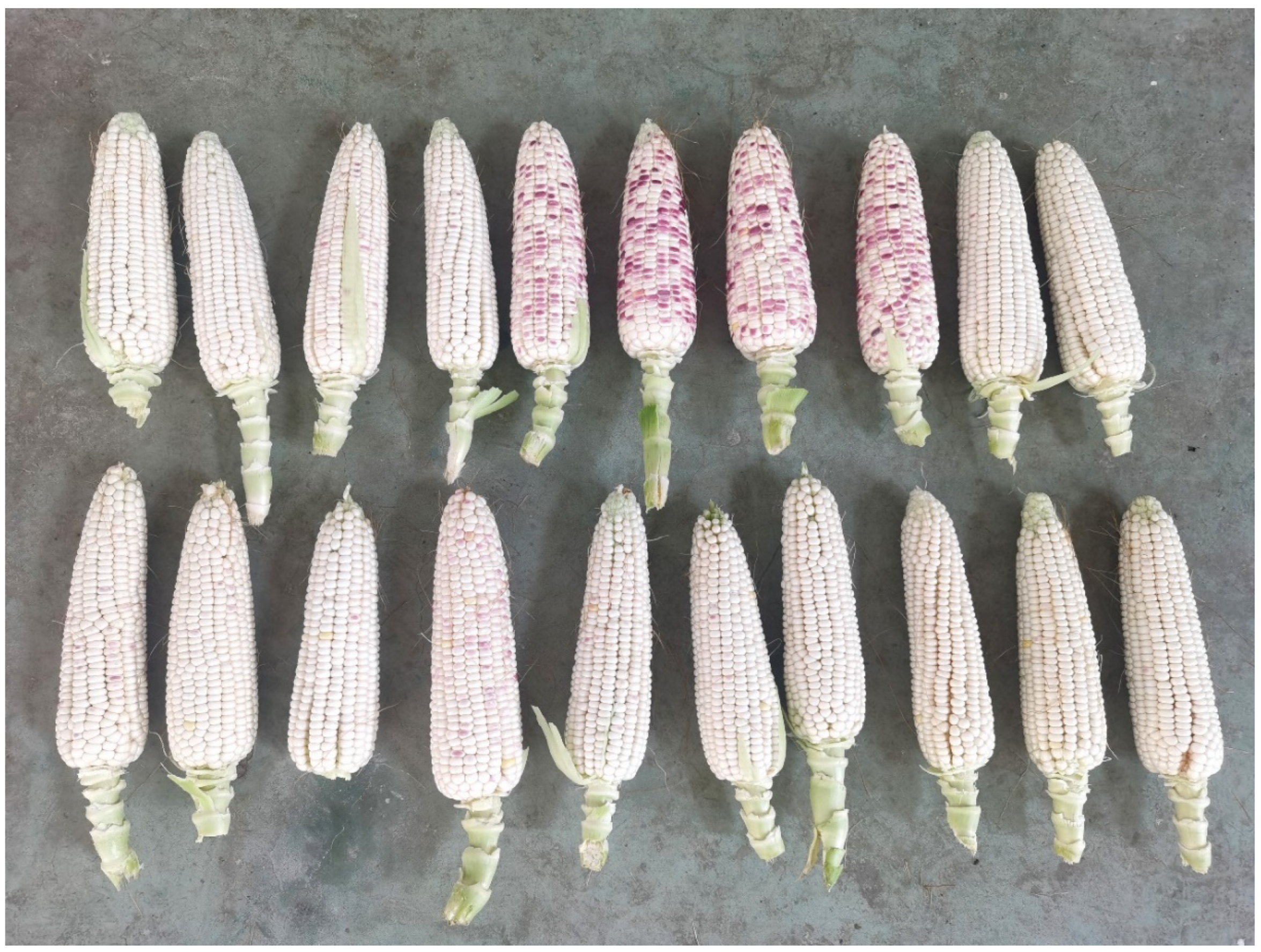
| Parameters | Average/mm | Maximum/mm | Minimum/mm |
|---|---|---|---|
| Length | 266.3 | 294.0 | 227.0 |
| Diameter | 65.5 | 69.2 | 59.6 |
| Levels | Factors | ||
|---|---|---|---|
| Peeling Roller Speed /(r·min−1) | Peeling Roller Tilt Angle /(°) | Frequency Vibration Plate /(times·min−1) | |
| −1 | 400 | 5 | 250 |
| 0 | 450 | 7 | 260 |
| 1 | 500 | 9 | 270 |
| No. | Test Factors | BPR% | GBR% | ||
|---|---|---|---|---|---|
/(r·min−1) | /(°) | /(times·min−1) | |||
| 1 | 400 | 7 | 270 | 87.59 | 1.87 |
| 2 | 450 | 7 | 260 | 93.54 | 1.46 |
| 3 | 450 | 7 | 260 | 91.56 | 1.38 |
| 4 | 500 | 7 | 270 | 89.06 | 2.03 |
| 5 | 450 | 9 | 270 | 86.59 | 1.69 |
| 6 | 450 | 7 | 260 | 94.02 | 1.42 |
| 7 | 450 | 5 | 250 | 92.34 | 1.92 |
| 8 | 400 | 5 | 260 | 86.98 | 1.57 |
| 9 | 450 | 7 | 260 | 93.28 | 1.21 |
| 10 | 500 | 9 | 260 | 90.01 | 1.76 |
| 11 | 450 | 7 | 260 | 93.89 | 1.33 |
| 12 | 450 | 9 | 260 | 88.79 | 1.53 |
| 13 | 400 | 9 | 260 | 87.98 | 1.67 |
| 14 | 500 | 5 | 260 | 91.21 | 2.13 |
| 15 | 450 | 5 | 270 | 90.06 | 1.97 |
| 16 | 400 | 7 | 250 | 86.78 | 1.63 |
| 17 | 500 | 7 | 250 | 92.59 | 1.98 |
| Source of Variance | SS | df | MS | F | p | Significance |
|---|---|---|---|---|---|---|
| Model | 101.43 | 9 | 11.27 | 7.68 | 0.0068 | ** |
| 22.92 | 1 | 22.82 | 15.61 | 0.0055 | ** | |
| 6.52 | 1 | 6.52 | 4.44 | 0.0731 | ||
| 6.48 | 1 | 6.48 | 4.41 | 0.0737 | ||
| 1.21 | 1 | 1.21 | 0.8244 | 0.3941 | ||
| 4.71 | 1 | 4.71 | 3.21 | 0.1164 | ||
| 0.0016 | 1 | 0.0016 | 0.0011 | 0.9746 | ||
| 22.79 | 1 | 22.79 | 15.53 | 0.0056 | ** | |
| 14.98 | 1 | 14.98 | 10.21 | 0.0152 | * | |
| 15.63 | 1 | 15.63 | 10.65 | 0.0138 | * | |
| Residual | 10.27 | 7 | 1.47 | |||
| Lack of fit | 6.33 | 3 | 2.11 | 2.14 | 0.2387 | |
| Pure error | 3.94 | 4 | 0.9858 | |||
| Total | 111.71 | 16 | ||||
| R2 | 0.908 |
| Source of Variance | SS | df | MS | F | p | Significance |
|---|---|---|---|---|---|---|
| Model | 1.13 | 9 | 0.1250 | 14.43 | 0.0010 | ** |
| 0.1682 | 1 | 0.1682 | 19.41 | 0.0031 | ** | |
| 0.1104 | 1 | 0.1104 | 12.75 | 0.0091 | ** | |
| 0.0312 | 1 | 0.0312 | 3.61 | 0.0993 | ||
| 0.0552 | 1 | 0.0552 | 6.37 | 0.0395 | * | |
| 0.0090 | 1 | 0.0090 | 1.04 | 0.3414 | ||
| 0.0030 | 1 | 0.0030 | 0.3491 | 0.5732 | ||
| 0.2874 | 1 | 0.2874 | 33.17 | 0.0007 | ** | |
| 0.1095 | 1 | 0.1095 | 12.64 | 0.0093 | ** | |
| 0.2765 | 1 | 0.2765 | 31.91 | 0.0008 | ** | |
| Residual | 0.0606 | 7 | 0.0087 | |||
| Lack of fit | 0.0232 | 3 | 0.0077 | 0.8289 | 0.5431 | |
| Pure error | 0.0374 | 4 | 0.0093 | |||
| Total | 1.19 | 16 | ||||
| R2 | 0.9489 |
| Indicators | Test Serial Number | Average Value | ||
|---|---|---|---|---|
| 1 | 2 | 3 | ||
| BPR% | 92.32 | 90.97 | 91.96 | 91.75 |
| GBR% | 1.58 | 1.56 | 1.51 | 1.55 |
Disclaimer/Publisher’s Note: The statements, opinions and data contained in all publications are solely those of the individual author(s) and contributor(s) and not of MDPI and/or the editor(s). MDPI and/or the editor(s) disclaim responsibility for any injury to people or property resulting from any ideas, methods, instructions or products referred to in the content. |
© 2023 by the authors. Licensee MDPI, Basel, Switzerland. This article is an open access article distributed under the terms and conditions of the Creative Commons Attribution (CC BY) license (https://creativecommons.org/licenses/by/4.0/).
Share and Cite
Chen, S.; Zhang, X.; Jiang, C.; Yi, K.; Wang, Q.; Sha, X.; Zhang, X. Experimental Study on the Peeling Fracture Effect of Fresh Corn Ear Based on High and Low Roller Peeling Equipment. Agriculture 2023, 13, 1585. https://doi.org/10.3390/agriculture13081585
Chen S, Zhang X, Jiang C, Yi K, Wang Q, Sha X, Zhang X. Experimental Study on the Peeling Fracture Effect of Fresh Corn Ear Based on High and Low Roller Peeling Equipment. Agriculture. 2023; 13(8):1585. https://doi.org/10.3390/agriculture13081585
Chicago/Turabian StyleChen, Shun, Xinwei Zhang, Chunxia Jiang, Kechuan Yi, Qingqing Wang, Xuemeng Sha, and Xiaolong Zhang. 2023. "Experimental Study on the Peeling Fracture Effect of Fresh Corn Ear Based on High and Low Roller Peeling Equipment" Agriculture 13, no. 8: 1585. https://doi.org/10.3390/agriculture13081585
APA StyleChen, S., Zhang, X., Jiang, C., Yi, K., Wang, Q., Sha, X., & Zhang, X. (2023). Experimental Study on the Peeling Fracture Effect of Fresh Corn Ear Based on High and Low Roller Peeling Equipment. Agriculture, 13(8), 1585. https://doi.org/10.3390/agriculture13081585





